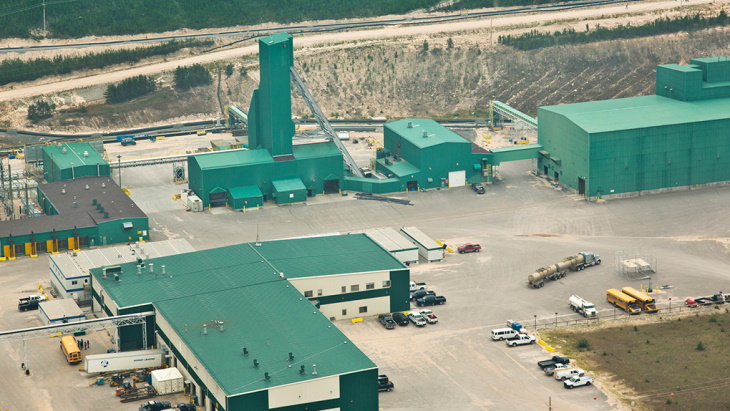Cameco has announced plans to restart uranium production at McArthur River/Key Lake, idled since 2018. The company plans to ramp up production at the operation in northern Saskatchewan to produce 15 million pounds U3O8 (5770 tU) per year starting in 2024, but aims to maintain "supply discipline", reducing production at Cigar Lake to 25% below its licensed capacity.

McArthur River (Image: Cameco)
"We see a market where fundamentals are shifting in our favour," Cameco President and CEO Tim Gitzel told investors in the company's conference call. Cameco's planned and unplanned production cuts, inventory reduction and market purchases, have since 2016 removed more than 190 million pounds U3O8 from the spot market, he said. The company has added 70 million pounds of long-term contracts to its portfolio since the start of 2021.
Coupled with increasing recognition around the world that nuclear energy will play a key role in achieving decarbonisation goals, it is easy to conclude that the uranium demand output is "durable and bright", he said.
"However, the uranium supply-side story paints a much different picture," he said. Persistently low prices have led to planned production curtailments at existing capacity, increased investment risk for new capacity, and the end of life of some mines. Secondary uranium supplies have in past filled market gaps, but such capacity is now declining significantly. This is further amplified by unplanned supply chain disruptions caused by the COVID-19 pandemic, global supply chain and economic challenges, while increased interest by investors sequestering large amounts of material has contributed to further thinning of the spot market. Increased interest in long-term contracting is emerging: Cameco has added some 70 million pounds of long-term contracts to its portfolio since the start of 2021, Gitzel noted.
"It is time for Cameco to proceed with the next phase of our supply discipline decisions," Gitzel told investors, operating McArthur River/Key Lake and Cigar Lake operating at less than licensed capacity starting in 2024. "We are taking a portfolio approach to our supply discipline. In 2021, we were operating at about 75% below productive capacity (100% basis), which came at a significant cost to our business. By 2024, we plan to be operating at about 40% below productive capacity (100% basis). This will remain our production plan until we see further improvements in the uranium market and have made further progress in securing the appropriate homes for our unencumbered, in-ground inventory under long-term contracts, once again demonstrating that we are a responsible supplier of uranium fuel," Gitzel said.
"Starting in 2024, it is our plan to produce 15 million pounds per year (100% basis) at McArthur River/Key Lake, 40% below the annual licensed capacity of the operation. At that time, we plan to reduce production at Cigar Lake to 13.5 million pounds per year (100% basis), 25% below its annual licensed capacity, for a combined reduction of 33% of licensed capacity at the two operations. In addition, we plan to keep our tier-two assets on care and maintenance, and production at Inkai will continue to follow the 20% reduction until the end of 2023 unless Kazatomprom further extends its supply reductions."
It will take some time to transition McArthur River/Key Lake from care-and-maintenance, Gitzel said. However, the operation could produce up to 5 million pounds U3O8 this year, depending on the completion of operational readiness activities including automation, digitisation and other projects, maintenance work and recruitment and training, and managing the potential risks from the pandemic and related supply chain challenges. Cameco will continue to meet sales commitments from a combination of its lower-cost production inventory and purchases, he added.
The company expects Cigar Lake production to be 15 million pounds U3O8 in 2022 (on a 100% basis).
McArthur River/Key Lake is described by Cameco as the world's largest high-grade uranium operation. Ore from underground mining operations at McArthur River is trucked 80 km south to be milled at Key Lake. Mining operations at Key Lake ended in 2002. Cameco is the majority owner and operator of McArthur River (69.8%) and the Key Lake mill (Cameco 83%), with Orano Canada owning 30.2% of McArthur River and 16.7% of Key Lake.
Nicolas Maes, CEO of Orano Mining, said the company is "fully confident" in Cameco's ability bring McArthur River/Key Lake into production on schedule. "Given the continued unbalanced uranium market conditions, the restart of McArthur gives us the opportunity to reduce production at Cigar Lake, extending the life of this asset and postponing the need for new projects in northern Saskatchewan," he said.
Orano Canada President and CEO Jim Corman said he was "optimistic" about the longevity of the Saskatchewan's uranium industry. "Following on the heels of our approval to expand the tailings management facility at McClean Lake, we now have a solid plan for uninterrupted production," he said.
Researched and written by World Nuclear News